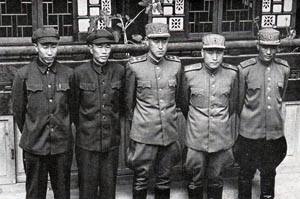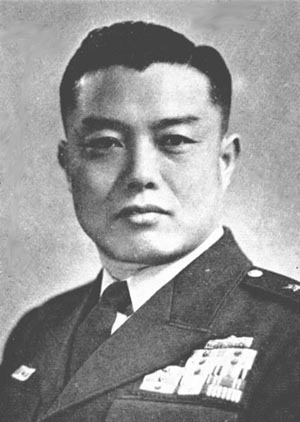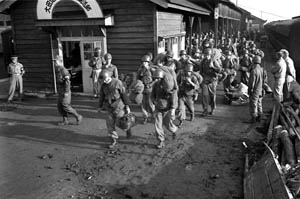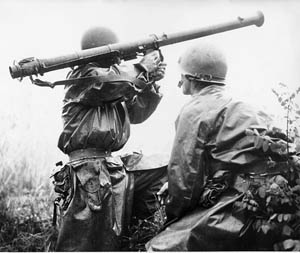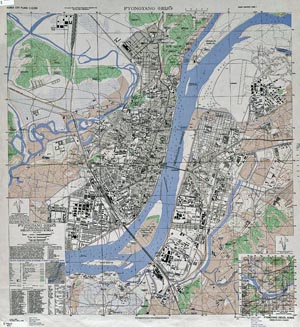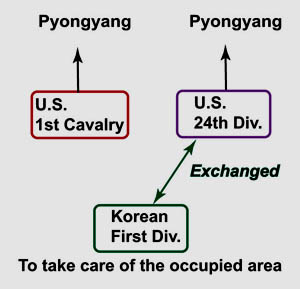Who started the Korean War?
- I have many written many articles on this issue. I will post them
when I have time. Let us start with the story you will never hear
from others.
June 4, 1950
written (2000.7.22) webpaged (20013.7.17)Apparently there still is the question of who started the Korean war, and many people still ask me what my opinion is on this question. This question should not exist because there were about 50,000 Korean troops stationed along the 38th parallel on 25th day of June 1950. Many died on that day, but many survived and told their horror stories, and they are still telling the story.
- Lee Sang-Jo was a high-ranking officer in the North Korean Army and was
one of the Northern delegates during the Panmunjom cease-fire negotiations
which lasted for two years (1952-53). Later, he had a quarrel with Kim
Il-Sung and exiled himself to Minsk (Belarus). When he visited Korea
about ten years ago, Korean reporters asked him who started the war.
His reply was "Why are you asking me this question? You already know.
If you still do not know, ask those Koreans who were at the front line
on the 6.25 day."
- About one month ago (June 2000), I attended a dinner hosted by the
Washington chapter
of the SNU Alumni Association, and the keynote speaker was an SNU man
working at the Korean Embassy in Washington. He was invited to speak
about the government's plan for reunification. Before explaining the
plan, he said he has done some research on who started the Korean War
and spent 20 minutes to explain his research result.
He said he was born in 1950 and the information he has is based on publications. He said the outbreak of the war shocked the entire world, and he presented an impressive list of the newspaper and broadcast reports during the period 6.25-29. He was bragging about the his research on Soviet news reports. His conclusion was that the question is still at large, and will never be settled. This is precisely what we expect from SNU people. They never know how to learn things from fellow Koreans. If he is so interested in this question, why did he not ask Koreans who were at the front line on the 25th day of June 1950?
- As for myself, I was on the 38th parallel just north of Seoul on the
fourth day of June (three weeks before the 6.25 day). I accompanied my
father who went there. He was a high-ranking supply officer at Korea's
Ministry of Defense, and was a member of the inspection team headed by
Col. Chang Do-Young who was the chief intelligence officer.
The team's mission was to find out what was going on at the 38th parallel. I listened carefully what field officers were telling to the inspection team. The soldiers there do not have enough ammunition for their rifles even for target practices.
- Col. Chang asked field commanders what was going on in the North?
They were constructing a road toward the boundary. What was the purpose
of the road? They had no idea. This was the end of the conversation about
the road.
The Korean army, including its intelligence chief, did not have enough military professionalism to analyze this crucial information. They did not know the purpose was to move their tanks rapidly from their hidden points in the North. Tanks were far beyond their imagination.
The only thing they knew about the Northern army was that they were equipped with hand-operated Mosin-Nagant rifles designed by Russians in 1891. Their conclusion was that they were safe as long as they had enough supply of ammunition for their semi-automatic M1 refiles. They did not know rifles (automatic or otherwise) are irrelevant against the tanks.

-
M1 Garand for the South (top), and Mosin-Nagant for
the North. Which one is superior? This is a useless
question in tank warfares.
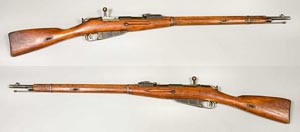
- When I tell this story to young Koreans, their answer is that they were
not born in 1950, and they cannot agree with me. I sometimes meet
Koreans from the North when I go to Russia. They become scared if I
tell them I look like Kim Il-Sung. On the other hand, they become very
friendly as soon as I speak with Pyongyang accent (my mother was from
Pyongyang). Then we get into the argument on who started
the Korean war. When I tell them I was at the tank-crossing point three
weeks before the 6.25 day, they ask me how old I was. They are at least
willing to listen.
- A similar situation exists on the question of who wrote the first Korean
version of the Bible. This question is not restricted to Christianity
in Korea. The Bible played an important role in teaching Koreans how to
use Hangeul. On this question also, Korean scholars always rely on
foreign publications, and they will never find the answer.
Click here for a story.
Koreans do not know how to ask questions and listen to fellow Koreans. This is the most serious tragedy for Korea. Unless we solve this problem, we will never earn respects from other people in the world. If we do not respect ourselves, how can we expect them to respect us?
- Let us reconstruct where those tanks were when Chang's inspection
team went to the 38th parallel on June 4, 1950.
- Before 1944, there was an elite Japanese combat unit called
the 77th Regiment, called "Chilsip-Chil Yondae" in Korean. This
word in quite familiar among those who lived in Pyongyang or had relatives
there. Here is a photo of its military
base. This place was used by Soviet troops after 1945, but
became the No. 1 military base for the North Korean army after
Soviets left in 1948.
- On February 8, 1848, the North
Korean army (called Chosun Inmin-Goon) was inaugurated with Kim Il-Sung
as the commander in Chief. But the training program for their
tank operators and air force pilots began much earlier.
- In June of 1950, those tanks were assembled on the ground of
the 77th Regiment. I met several people who saw those tanks
there. They are among those Korans who came to the South during
the 1.4 retreat of 1951.
- I also met one person who came from Sariwon. He saw the
tanks being transported to south on railroad cars. It was done
during daytimes. Sariwon is a major railroad crossing point
south of Pyonyang. It now serves as the capital city of North
Hwanghae Province.
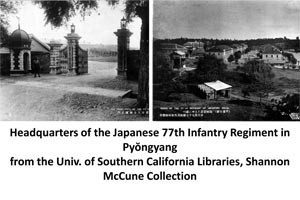
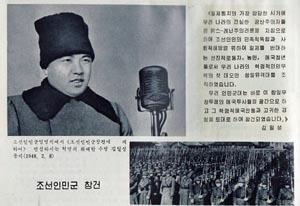
- Before 1944, there was an elite Japanese combat unit called
the 77th Regiment, called "Chilsip-Chil Yondae" in Korean. This
word in quite familiar among those who lived in Pyongyang or had relatives
there. Here is a photo of its military
base. This place was used by Soviet troops after 1945, but
became the No. 1 military base for the North Korean army after
Soviets left in 1948.
June 25-30, 1950
- In 1950, KBS (Korean Broadcasting System) operated with three transmitters.
Its medium-wave (970 khz) main transmitter was 50 KW strong, and was
able to cover the entire Korean peninsula and southern Manchu. It
also had two 1-KW short-wave transmitters, one with 2.51 mhz and the
other with 3.975 mrz. From the technical point of view, the KBS was a
very powerful station. However, Koreans could not provide interesting
radio programs. Thus, the morning program stopped at 8.00 AM, and
the day-time program started at 12.00 noon and lasted for only one
hour until 1:00 PM.
- On Sunday, June 25, at 1:00 PM, the KBS announcer (Yoon Young-Ro)
said the broadcasting would stay on, and the station kept sending out
military marches. At 1:11 PM, the announcer gave an important news:
North Korean army units crossed the 38th line. The news also said
the Soviet-built tanks were leading the army units on the Dong-Duchun
front, directly north of Seoul.
- Immediately after the war news on June 25, the KBS radio was
telling how bravely our army was fighting, and the unification of
the country would be accomplished within a week. However, the
atmosphere was quite different. The re-enforcement troops going
to the front line were equipped with the 99-style Japanese rifles,
and their faces were quite grim. They ran out of the ammunition
for their M-1 rifles.
Three weeks earlier on Sunday, June 21, I accompanied my father who was one of the members of the team who went to the Dong-Duchun front to inspect the situation there. He was a high-ranking navy officer in charge of logistics at the ministry of defence. The head of the inspection team was Colonel Chang Do-Young. The members were quite relaxed and attempted to get alcoholic verbiages during their lunch hour at a local restaurant. However, the restaurant owner said it was illegal to provide alcohols during the day time.
At that time, the 7th Division of the Korean army was guarding the 38th line there. I spotted a couple of machine gun posts, and nothing of military significance.
On Monday, June 26, we all went to school, and our school principal gave a long sermon about how we should behave during the war environment. He was talking about German students in their classrooms while bombs were dropping outside. He did not know what was going to happen next day.
- On Tuesday, June 27, the situation became grave. We were all sent
back from the school in the morning. In the early evening of June 27,
two North Korean fighers (YAK-9) flew over Seoul and dropped leaflets,
telling they will liberate the citizens of Seoul from American imperialism.
Yet, the KBS radio was reporting how bravely our troops are fighting
and scoring battle successes. Furthermore, the radio saied the city
of Haeju (in the north) was occupied completely by our 17th Regiment
from Ongin.
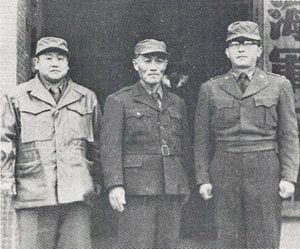
-
Shin Sung-Mo in the middle. With him were Chae Byung-Duk (left) and
Chung Il-Kwon. This photo was taken in July of 1950 when Chung
replaced Chae as the army chief.
- In the early morning of June 28, Shin Sung-Mo, the defense minister,
made a special announcement saying that the NK army came close to Seoul,
and the Korean government was moving to Suwon, 100 km south of Seoul.
My family sensed that the Han-Gang River could be a good defense line, and moved to our friend's house at No-Ryang-Jin (south of the river) on June 28. In the morning of June 29, around 4.00 AM, we heard two giant explosions. The Hangang bridges were destroyed. We then walked all the way to Suwon. After spending one night there, we were waiting for a train to Dae-Jun on June 30.
- While waiting for the train, we saw a big four-engined American plane
approaching the Suwon airport. Then we heard machine-gun noise. I did
not know what was going on at that time. Later, I learned that Gen.
Douglas MacArthur was coming from Tokyo on his plane called "Bataan."
A North Korean Yak-9 fighter was attempting to shoot down Mac's plane.
The F-80 jets of the U.S.Air Force were chasing away the NK Yak fighter.
I think I am the only one to see this scene and to tell the story in
detail.

Day of Confusion (June 28, 1950)
- In the early morning of June 28, 1950, Shin Sung-Mo
(defense minister) made a statement saying that the North Korean
troops approached the northern boundary of Seoul, and the citizens
became horrified. Shortly after his statement, the radio said Shin's
statement was in error, and the our defense of Seoul is iron-clad.
The radio kept saying that our brave troops were chewing up the troops of
the NK puppet regime.
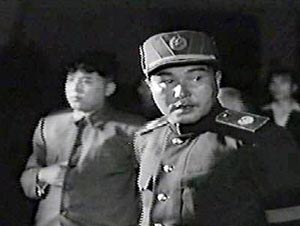
-
Choe Yong-Gon (1900-1976),
with Kim Il-Sung (1951). He built his military
experience while in the Chinese communist army.
- In the meantime, the NK troops were consolidating their positions
in the Miari hills at the northern boundary of Seoul. The commander
of their troops was
Choe Yong-Gon, who was a experienced military
man. Instead of marching into Seoul during the day time, he wanted
to avoid street fighting. He wanted to let all South Korean troops run
away to the south on June 28, and march into the Seoul in darkness
during the night of June 28-29. Indeed, they did. The citizens
of Seoul saw NK tanks in the morning of June 29.
When the defense minister was making his statement in the morning of June 28 that the capital city would be moved to Suwon, President Yi Seung-Mann was already on a train heading toward Daejun. He was desperate to open a appropriate channel to the president of the United State. The only way to save him and his country was to bring in American troops stationed in Japan.
I did not hear, but I heard from others saying that he broadcasted a message saying that Soul would be defended. I also heard that Lady Mo Yoon-Sook read her poem toward the NK soldiers to stop fighting and killing.
- During the day time of June 28, I was tuned to the KBS radio.
Perhaps, I am the only one who could tell what the radio sent out.
My family crossed the Hangang bridge to south in the early evening
of June 28.

-
This photo was taken in Kharkov (Ukraine). I look OK with a
lady, soldiers, and a T-34 tank.
Kharkov is an Ukrainian city where the Soviet engineers developed their T-34 tanks. While Kharkov was occupied by German troops during World War II, Soviets moved their tank factory to an Ural-mountain city of Chelyabinsk, where they mass-produced those T-34 tanks. With those tanks, Soviets scored a decisive victory over the German army at the Kursk (south of Moscow) tank battle of 1943. From there, Germans started losing the war. Here is my photo with one of the Kursk veterans.
Stalin initially gave 200 of those T-34 tanks to Kim Il-Sung in 1948. They showed up in Seoul in the morning of June 29, 1950.
I once went out with a Russian young lady whose grandmother worked at the tank factory in Chelyabinsk during World War II. It was an out-door factory. Soviets did not have enough time and resources to construct the factory buildings.
- On June 28, 1950. North Korean troops with their T-34 tanks were
assembling on the northern suburb of Seoul, in preparation for their
entry to the city during the dark hours of June 28-29. The
(south) Korean government abandoned the city and moved to Suwon.
The Seoul radio station was
manned by the chief announcer named Yoon Young-Ro and Col. Kim Hyun-Soo
who was the chief public relations officer of the army.
Since there were no good news to tell, these two people had to make up stories, and played one of the Sousa marches between those incoherent stories. Like to hear that music?
- It was the National Fencibles March by John Philip Sousa.
Both Mr. Yoon and Col. Kim were gunned down by the North Korean troops who came to the radio station in the early morning of June 29, 1950.
Two Infantry Divisions of the U.S. Army
-
written (2000.2.29) webpaged (2013.7.20)
- By June 29, 1950, four days after the North Korean army crossed the
38th parallel, the (south) Korean
Army completely lost its combat capability. It is not difficult to
understand how this happened if you see the
photos of the tanks the North Korean Army had.
Then the United States re-assembled its 24th Division stationed in Japan and sent it to Korea in hurry. The troops of the 24th Div. brought with them six 2.36-in bazooka launchers and 40 rounds of ammunition. I saw those troops. Their calculation was that those North Korean invaders would become scared and would run away to the North.
- When they met the North Korean tanks in Osan on July 5 (1950), they
sent the first shots to the tanks, but nothing happened. To make things
worse, those tanks did not even reciprocate the courtesy of returning
the fire. You really have to see those unruly tanks by visiting
this webpage. In the battle of Daejon, the
24th Div. lost one third of its troop strength including its division
commander.
The division commander was Major General William Dean. He was captured by North Koreans and stayed at their POW camp until the POW exchange process following the cease-fire agreement of July 27, 1953.
- In the meantime, the First Cavalry Division was on the Pacific Ocean
on its way from Texas. The troops finally landed in Pohang on July
16. They then replaced the wounded 24th Division. Later, the First
Cav. got combined with the 24th Div. and the First Div. of the
Korean army into the First Corps of the U.N. Army.
You will then be interested in how Koreans got along with their American counterparts. I wrote an article about this problem in 1997, but decided to rewrite it in order to emphasize what I really want to say in these articles: Koreans have enough wisdom and strength to deal with discriminations if they exist. Please continue reading.
American Wheels and Korean Legs
-
written (1997.8.5) webpaged (2013.7.20)
- On one of his side arms, General Tilelli was wearing an insignia for
the U.S. First Cavalry Division (black horse on yellow background).
This unit is now stationed in Fort Hood (Texas). If you are attending
the Univ. of Texas in Austin, you should be able to spot the soldiers
wearing the black-yellow insignia. In order to impress Tilelli, I
told him that he should not be in Korea but should be in Texas.
He then said I am only half-smart about the U.S. Army. If a general carries enough stars, he can wear the unit insignia most meaningful to him. In his case, he was the commander of the First Cavalry when the unit was sent to Saudi Arabia during the Gulf-war period, and he was proud of the mission he carried out. Yes, the First Cavalry and the 24th Division formed the main muscle of the U.S. Army in the Gulf region in 1990 and 1991.
- In October of 1950, the UN (US and Korean) forces were ready to march
toward north to liberate Pyongyang, and the UN Command initially
positioned the First Cav. and the 24th Division in the left flank and
the right flank respectively, while leaving the first Korean Army
Division as a reserve in the rear. This meant that Pyongyang was
going to be occupied by American troops first. This was going to be
a disaster to Koreans, and had to be prevented at all costs.
-
Under a strong protest from Koreans, the 24th Div. was replaced by the First
Korean Army Division, but it was beyond Americans' imagination for
Koreans to reach Pyongyang before their Cav. Division. This Cav.
Division was initially created as a fast-moving unit during the horse
era, and maintained its mobility during the post-horse era. In Korea,
the Division was equipped with more than 1,000 motor vehicles including
state-of-the-art troop carriers. In contrast, the Korean Division
had only 50 Nissan trucks (junk cars at that time).
The race was very simple. Americans are on the wheels and Koreans had to walk. This was how the six-day race began. I would not tell this story if the result had been consistent with what young Koreans could expect these days. Yes, Koreans at that time were creative enough to produce miracles. It was a torturous to walk and run without sleep for six days, but they reached Pyongyang before Americans did. Remember that hard work is an integral part of creativity.
The commander of the Korean Division was Paik Sun-Yup with one star at that time. Two years later, in 1952, he became the Army Chief of Staff. He then became Korea's first four-star general. In 1950, he explained to his troops why Koreans had to get to Pyongyang before Americans, and said loudly "I will walk and you will follow me."
- Gen. Paik, who was initially trained as an officer in the Japanese army,
never understood why soldiers had to wear neckties. Thus, he always
came to ceremonies in his combat fatigue without necktie. He did not
carry his pistol, but he always had his water canteen hanging on his
belt. Koreans were then quick to produce a joke that Paik was not
carrying water in his canteen, but wine or whisky. They nicknamed
the canteen as "Paik Sun-Yup's Sool-tong." These days, it's official
name is "Soo-tong," but our young soldiers do not know the history.
In 1985, I met a Korean army officer. In order to kihap him, I asked him why the canteen is called "Soo-tong" instead of a more natural word "Mool-tong." To my surprise, he had a clear understanding of its history. He told me he can tell the alcoholic content of the liquid inside by looking at the canteen. I asked him how. He was quite scientific in his explanation, but I do not know whether his theory works in the real world. He said he definitely can tell, and I had to trust him. Who says Koreans lack imagination?

|
Taylor later served as the Army Chief of Staff, the Chairman of the Joint Chiefs, and the Ambassador to Vietnam during the Vietnam build-up period (before 1965). I was thus able to show off my photo with Taylor to American friends. When the friends asked me what the occasion was, I used to tell a lie that I destroyed one Soviet-built NK tank with a gasoline bottle. This was a joke, but some Americans believed my made-up story.
copyright@2013 by Y. S. Kim.
Unless otherwise specified, all photos are from the public domain, the Wikipedia fair-use domain, the North Korean propaganda literature, or from my personal collection.
|
- Click here for his home page.
- His photo-biography.
- His Einstein page.
- His Princeton page.
- His Style page.

I received my PhD degree from Princeton in 1961, seven years after high school graduation in 1954. This means that I did much of the ground work for the degree during my high school years.
